| Srl | Item |
| 1 |
ID:
171172
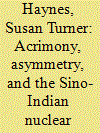

|
|
|
|
|
| Summary/Abstract |
While most contemporary analyses of South Asian nuclear dynamics acknowledge the presence of a strategic triangle between the region’s three nuclear players, the primary focus usually remains on the rivalry between India and Pakistan. Discussions of Sino-Indian relations remain limited. This is likely attributed to the stability in the two countries’ relations, yet it is worth asking why this stability exists and whether it is likely to continue in the future. Although China and India have an acrimonious relationship, their asymmetric nuclear capabilities and threat perceptions mitigate the danger of a traditional security dilemma. India may perceive China’s nuclear aggrandizement to be a security threat, but the same is not true of China, which has a vastly superior nuclear force and is largely shaping its nuclear-force structure in response to the threat it perceives from the United States. This dynamic makes a serious conventional or nuclear conflict highly unlikely.
|
|
|
|
|
|
|
|
|
|
|
|
|
|
|
|
| 2 |
ID:
113701


|
|
|
|
|
| Publication |
2012.
|
| Summary/Abstract |
This article explores change and conceptual innovation in Chinese nuclear weapons strategy. It argues that drastic change towards a war-fighting strategy is not considered likely. Some transition is underway, towards what some have termed assured retaliation, but this transition is not a dramatic departure from past strategy which was based on uncertain retaliation. To illustrate this view, the article focuses on three areas: declaratory nuclear policy, military modernization, and academic discussions among military and civilian strategists in China. Declaratory policy offers a useful lens through which to consider Chinese nuclear strategy, especially nuclear deterrence and the policy of no first use. For its part, China's ongoing military modernization has been a source of much concern in the West, but here a distinction is made between nuclear and non-nuclear modernization, and emphasis is placed on how both underpin no first use. Lastly, in Chinese academic circles, discussions have expanded upon declaratory policy and introduced innovative ideas on how best to shape future strategy. These discussions represent important efforts to demystify misconceptions regarding Chinese strategy, moving beyond traditional frameworks of analysis such as minimum deterrence, towards concepts such as counter-coercion.
|
|
|
|
|
|
|
|
|
|
|
|
|
|
|
|
| 3 |
ID:
058217
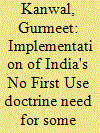

|
|
|
| 4 |
ID:
167793
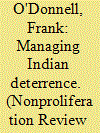

|
|
|
|
|
| Summary/Abstract |
India is developing new nuclear force options in response to what it perceives as a deteriorating strategic environment. New Delhi has historically adhered to the nuclear strategic concept of “credible minimum deterrence,” defined as maintaining a small, survivable nuclear force at low readiness in peacetime, which poses a credible risk of nuclear retaliation to adversaries but does not guarantee it. However, India’s stated commitment to credible minimum deterrence is currently challenged by four specific developments: the gradual weakening of elite support for India’s no-first-use policy; the decision of its defense scientific agency to pressure policy makers by publicly announcing it can field tactical nuclear weapons; the shift of Indian Air Force planning toward potential counterforce strikes; and New Delhi’s unclear intentions concerning ballistic-missile defense. This article concludes that India faces a choice between two distinct nuclear-policy pathways: retaining its adherence to credible minimum deterrence, or permitting increasing ambiguity surrounding its true nuclear doctrine and posture. The article evaluates these nuclear-policy options and concludes that credible minimum deterrence remains more consistent with Indian national-security and foreign-policy goals.
|
|
|
|
|
|
|
|
|
|
|
|
|
|
|
|
| 5 |
ID:
180283
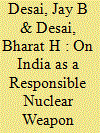

|
|
|
|
|
| Summary/Abstract |
India conducted Operation Shakti (Pokhran II) nuclear tests during 11–13 May 1998 that ushered her into the cherished nuclear weapons club. It was well calibrated decision to formally choose the nuclear path through the first peaceful nuclear explosion, Smiling Buddha (Pokhran I) that was conducted on 18 May 1974. It was significant that without joining the 1968 Nuclear Non-proliferation Treaty, India managed to gatecrash into the nuclear weapons capability. It led to articulation of the No First Use (NFU) doctrine on 4 January 2003 (Ministry of External Affairs [MEA], 2003). In the wake of 16 August 2019 pronouncement of the Indian Defence Minister on possible review of the NFU, this article seeks to probe the question: Does the NFU doctrine require any such review? It comprises the rational, the promise of NFU, counterforce strategies, NFU with respect to tactical nuclear weapons and associated problems with First Use and NFU.
|
|
|
|
|
|
|
|
|
|
|
|
|
|
|
|
| 6 |
ID:
150945
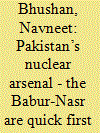

|
|
|
| 7 |
ID:
107233
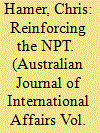

|
|
|
|
|
| Publication |
2011.
|
| Summary/Abstract |
Former Prime Minister Kevin Rudd reaffirmed Australia's commitment to realising a world free from nuclear weapons. Arguments are presented here that this aim cannot be achieved until the framework of international law and international governance has been substantially strengthened. A more productive aim at the present time would be to fortify the Non-Proliferation Treaty with a 'no first use' declaration by the nuclear-weapon states, so that the non-nuclear-weapon states can rest secure in the knowledge that nuclear weapons will not actually be used again, pending the day when they can safely be discarded entirely.
|
|
|
|
|
|
|
|
|
|
|
|
|
|
|
|
| 8 |
ID:
146552
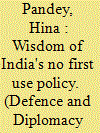

|
|
|